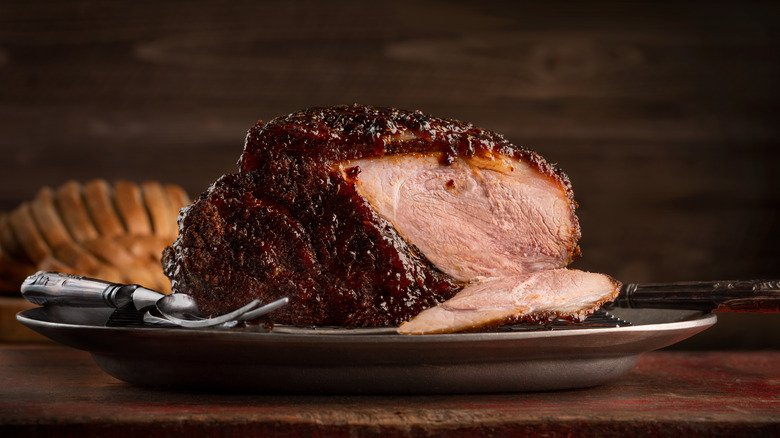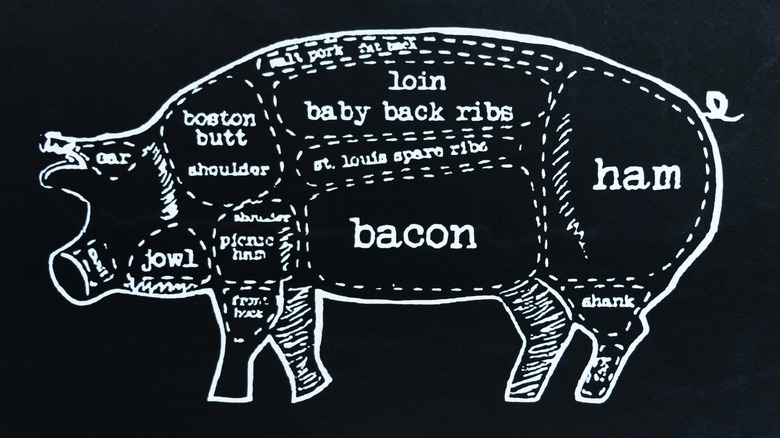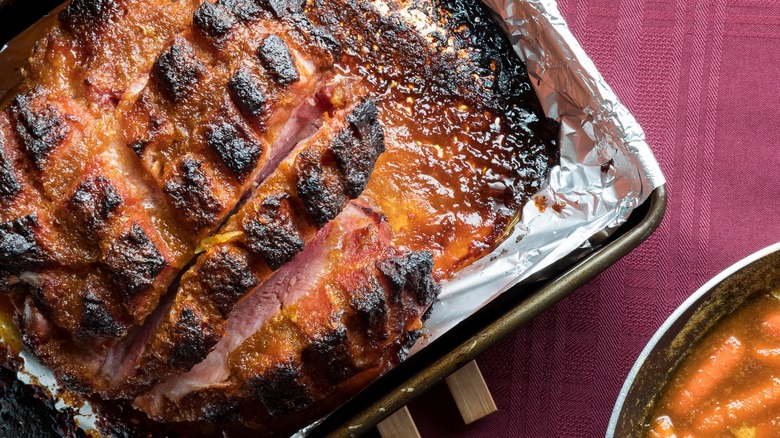Is There A Flavor Difference Between Pork Shoulder And Pork Butt?
Have you ever found yourself at the butcher's counter trying to understand which roast you need to order: pork shoulder or pork butt? Both are often called for in recipes, and while they sound like they come from opposite ends of the animal, they actually are in close anatomic proximity.
In fact, pork butt gets its name from how the meat was once packed. In colonial New England, it was stored in large drums called butts. To this day, the roast will occasionally still be labeled as Boston butt. Pork shoulder, on the other hand, is often labeled as picnic shoulder.
The two cuts come from right next to each other on a pig: the shoulder. Pork butt is located just above picnic shoulder, and it has more marbling and fat. This high fat content means that pork butt isn't as prone to drying out over a long cooking period. Pork butt can be sold bone-in, but is often sold bone-out as well.
Picnic shoulder, for its part, is a leaner cut. It is usually sold with the bone in, and it comes in a triangular shape with one end tapering down. This cut is almost exclusively sold with the skin on.
How flavor is impacted
To understand the nuances of these two roasts, it helps to look more closely at the area where they are found. A pig's shoulder gets worked out regularly, creating thick muscle strands that will break down when cooked slowly, transforming into meltingly soft meat. Compare this to the pork loin, for example (which comes from a sedentary part of the animal that doesn't get worked out), which is an extremely lean cut that needs to be cooked quickly to avoid drying out. A general rule of thumb is that any part of the animal that gets worked out regularly needs to be cooked much longer than a part that doesn't.
So how does all of this affect flavor? Both pork shoulder and pork butt have deeper flavor than leaner parts of the animal. Pork butt, however, will be richer because of its fat content. Picnic shoulder is a bit leaner, which gives it a lighter, slightly less savory taste. Its meat can also come out with a stringier texture because of this facet. On the other hand, picnic shoulder offers the flavor of skin that pork butt does not have. When cooked well, this skin will offer a crisp textural contrast and a delicious savory kick.
When to use pork shoulder vs. pork butt
Both of these cuts are ideal for long cooking applications, which allows their muscle fibers and collagen to break down. Each one offers specific advantages for different recipes, however.
Pork butt is easier to cut up into uniform chunks, making it ideal for dishes like 60-minute carnitas. It can also be cut into thin steaks and cooked similarly to a pork chop, or roasted until tender but still sliceable. (Picnic shoulder will not be ideal for these applications because its unwieldy shape makes it difficult to slice.) Pork butt is also a great choice to grind up into pork sausage due to its fat content and deep flavor.
You should turn to picnic shoulder when you want to cook up a whole roast with shatteringly crisp skin like slow roasted pork adobo. As the meat roasts, the skin on top will slowly crisp up until you're left with pork cracklings. This cut will look especially impressive served whole. Try roasting it at a low temperature and serving it at a dinner party with fixings on the side.



